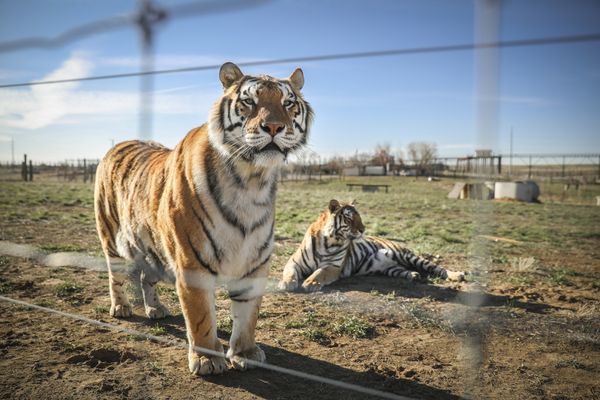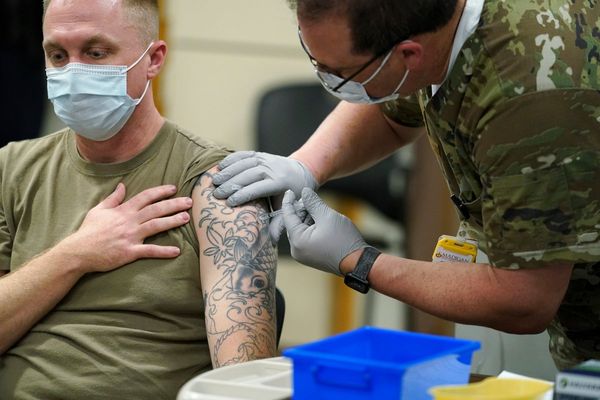
In 1969 Fred Eversley was living in Venice Beach, Los Angeles, surrounded by artists from the loosely constructed Light and Space movement, which cultivated a futuristic mode of sculpture defined by its minimalism and geometric abstraction. He was relatively new to artmaking, but knew from his former career as an aerospace engineer that to make a true parabolic sculpture – an exactly symmetrical concave, something of a holy grail among his peers – would be achievable only through casting liquid resin while it rotates on a vertical axis.
Eversley, who has died aged 83, set about building the necessary kit in his studio, dismantling existing tools and machinery for parts, eventually creating a Frankenstein turntable – inspired by a 1940s-era technology that originally cast nuclear bomb components – on which a circular mould was affixed.
He then sourced liquid polyester, which he dyed in an eclectic range of colours, and spun the material in concentric layers using gravity to build up a series of monumental blocks.
The results Eversley cut and polished until they resembled gleaming futuristic towers or partially transparent portals, as slick as the production was jerry-built: Untitled (1969), one of the earliest of these experiments, is a pedestal mounted cut-shard of purple, green and orange coloured resin bleeding into itself, an alien object reminiscent only of a block of kryptonite from the Superman comics; while Untitled (parabolic lens) (1978) feels like an inverse eclipse, a spectacular green concave circular block with a jet black outer edge.
“I am interested in the sculpture’s ability to refract and reflect light, as well as its surroundings,” Eversley said in 2023. “Both of these things have always been my primary motivation. I want to attract and give back energy to the viewer.”
Eversley was born in New York to Beatrice (nee Syphax), a school teacher, and Frederick Eversley, a Barbados-born chief engineer at a military aviation company. Fred went to the 149 Elijah D Clark junior high school, but his real education came from accompanying his hobbyist-inventor grandfather to a local electrical supplies store; Fred learned morse code and would borrow his father’s popular science magazines.
In 1959 he enrolled at Brooklyn Technical high school and, after summer shifts with his father’s employer, he continued the engineering path at Carnegie Institute of Technology (now Carnegie Mellon University), as the only black student on the course.
Graduating in 1963, Eversley secured a position as chief of “special projects” at the California-based Wyle Laboratories, a loosely defined position that sent him to Denmark and Sweden to source parts for clients including Nasa and the US defence department (Fred using the opportunity to acquaint himself with the Scandinavian jazz scene). In the evenings he took night classes in French, beat poetry and photography, gradually becoming friendly with the wife of his boss, Edith Wyle, a patron of the arts and friend of painters including Lee Mullican and Luchita Hurtado.
In January 1967, while trying to push-start his stalled MG out of the Wyle carpark, Eversley broke his femur. He was on crutches for 13 months and, despite being newly promoted at Wyle with a team of a dozen under him, was forced on to sick leave. The convalescence took him beyond his 26th birthday and out of contention for the Vietnam draft (from which his job hitherto had offered protection).
With days spent off work at home in Venice Beach, a bohemian area that was one of the few in the city where a black man could rent an apartment, Eversley decided he would not return to the nine-to-five. Beginning with photography, a passion which he also inherited from his grandfather, he went on to assist the kinetic artist Charles Mattox, a neighbour, who introduced him to the Space and Light fraternity and figures including James Turrell, Larry Bell and Robert Irwin.
“I retired from engineering. I was living in Venice, California surrounded by all the artists and all the jazz people and all of that, and I just started making art, and I had success. I was having shows three months after I started making.”
In 1970 he had a solo exhibition at the Whitney Museum in New York, and exhibitions with commercial galleries in New York and Chicago; and three years later his work was featured in the Whitney Biennial. In 1976 Eversley exhibited at the National Academy of Science, Washington, DC, and Los Angeles Institute of Contemporary Art. He was appointed artist in residence at the National Air and Space Museum, Washington, DC, in 1980. His newfound fame granted him access to spaces he had never encountered before as a black man, recalling that on attending a gala at the Museum of Fine Arts in Houston, he found “I was the only black person except for the waiters.”
His works grew bigger and he went on to create more than 20 public sculptures, many permanent. In 1980 he was commissioned to produce a work at Miami International Airport, producing Parabolic Flight, two 10.6m parabolic forms in stainless steel, installed in such a position that they could harness wind power to operate an LED strip attached to the edge of one of the towers.
In 2023 Eversley was commissioned to produce a new parabolic tower in Central Park in New York: Parabolic Light (cylindrical lens) is a 3.6m pink-tinged polyurethane obelisk which reflects and refracts the surroundings. The same year he had the first of two shows at David Kordansky Gallery in New York, and his work was included in the 2024 iteration of the California-wide PST Art +Science festival.
He is survived by his wife, Maria Larsson, an artist and architect, his sister, Rani, and brothers, Donald and Paul.
• Frederick John Eversley, artist, born 28 August 1941; died 14 March 2025







